

List of flood myths. The Flood myths or deluge myths are, taken collectively, stories surviving from human prehistory, of a great flood which has generally been taken as mythical.

These legends depict global flooding, usually sent by a deity or deities to destroy civilization as an act of divine retribution. Flood stories are common across a wide range of cultures, extending back into prehistory. Below is a list of some flood stories from around the world and is in no way exhaustive. West Asia and Europe[edit] Ancient Near East[edit] Sumerian[edit] Sumerian creation myth Babylonian (Epic of Gilgamesh)[edit]
Matsya. The earliest accounts of the legend associate Matsya with the creator god Prajapati (identified with Brahma).
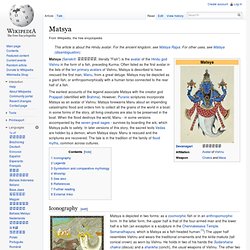
However, Puranic scriptures incorporate Matsya as an avatar of Vishnu. Nanabozho. Manabozho in the flood.
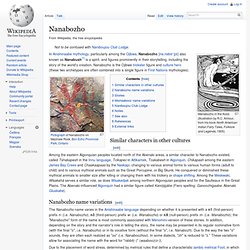
(Illustration by R.C. Armour, from his book North American Indian Fairy Tales, Folklore and Legends, 1905) In Anishinaabe mythology, particularly among the Ojibwa, Nanabozho [nɐˌnɐbʊˈʒʊ] also known as Nanabush[1] is a spirit, and figures prominently in their storytelling, including the story of the world's creation. Nanabozho is the Ojibwe trickster figure and culture hero (these two archetypes are often combined into a single figure in First Nations mythologies). Similar characters in other cultures[edit] Among the eastern Algonquian peoples located north of the Abenaki areas, a similar character to Nanabozho existed, called Tshakapesh in the Innu language, Tcikapec in Attikamek, Tcakabesh in Algonquin, Chikapash among the eastern James Bay Crees and Chaakaapaas by the Naskapi, changing to various animal forms to various human forms (adult to child) and to various mythical animals such as the Great Porcupine, or Big Skunk.
Nanabozho name variations[edit] Gilgamesh flood myth. Utnapishtim, or Utanapishtim, is a character in the epic of Gilgamesh who is tasked by Enki (Ea) to abandon his worldly possessions and create a giant ship to be called The Preserver of Life.
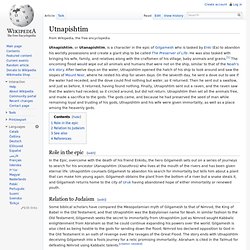
He was also tasked with bringing his wife, family, and relatives along with the craftsmen of his village, baby animals and grains.[1] The oncoming flood would wipe out all animals and humans that were not on the ship, similar to that of the Noah's Ark story. After twelve days on the water, Utnapishtim opened the hatch of his ship to look around and saw the slopes of Mount Nisir, where he rested his ship for seven days.
Deucalion. Deucalion from "Promptuarii Iconum Insigniorum " Etymology[edit]
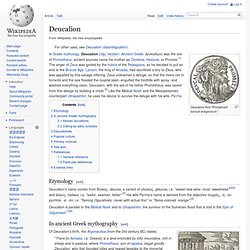
Manu (Hinduism) Matsya protecting the Manu and the seven sages at the time of Deluge In some Hindu traditions, Manu is a title accorded to a progenitor of humanity.
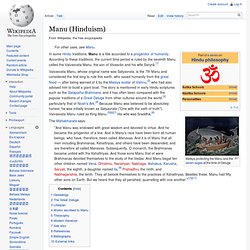
According to these traditions, the current time period is ruled by the seventh Manu called the Vaivasvata Manu, the son of Vivasvân and his wife Sanjnâ.[1] Vaivasvata Manu, whose original name was Satyavrata, is the 7th Manu and considered the first king to rule this earth, who saved humanity from the great flood — after being warned of it by the Matsya avatar of Vishnu,[2] who had also advised him to build a giant boat. The story is mentioned in early Hindu scriptures such as the Satapatha Brahmana, and it has often been compared with the popular traditions of a Great Deluge from other cultures around the world,[3] particularly that of Noah's Ark.[4] Because Manu was believed to be absolutely honest, he was initially known as Satyavrata ("One with the oath of truth"). Vaivasvata Manu ruled as King Manu.[5][6][7] His wife was Sraddha.[8] Noah's Ark. Noah's Ark (1846), a painting by the American folk painter Edward Hicks A ship modeled after the biblical description of Noah's Ark, Ark van Noach, in the Netherlands Noah's Ark (Hebrew: תיבת נח; Biblical Hebrew: Tevat Noaḥ) is the vessel in the Genesis flood narrative (Genesis chapters 6–9) by which Noah saves himself, his family, and a remnant of all the world's animals from the flood.
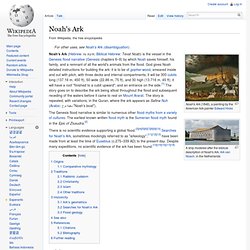
God gives Noah detailed instructions for building the ark: it is to be of gopher wood, smeared inside and out with pitch, with three decks and internal compartments; it will be 300 cubits long (137.16 m, 450 ft), 50 wide (22.86 m, 75 ft), and 30 high (13.716 m, 45 ft); it will have a roof "finished to a cubit upward"; and an entrance on the side. The story goes on to describe the ark being afloat throughout the flood and subsequent receding of the waters before it came to rest on Mount Ararat. The Genesis flood narrative is similar to numerous other flood myths from a variety of cultures. Origins[edit] Flood myth. "The Deluge", frontispiece to Gustave Doré's illustrated edition of the Bible.

Based on the story of Noah's Ark, this shows humans and a tiger doomed by the flood futilely attempting to save their children and cubs. A flood myth or deluge myth is a symbolic narrative in which a great flood is sent by a deity, or deities, to destroy civilization in an act of divine retribution.